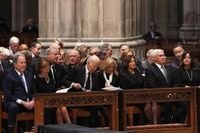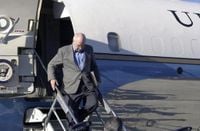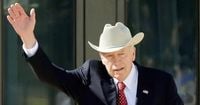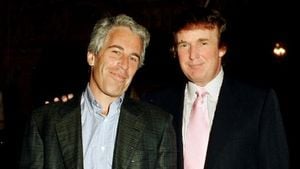In the heart of Washington, D.C., on November 20, 2025, the nation gathered to bid farewell to one of its most consequential and polarizing public figures: former Vice President Dick Cheney. His funeral, held at the National Cathedral, was not just a moment for political eulogies, but a window into the legacy of a man whose influence rippled through American politics, energy policy, and, most personally, his own family.
Cheney, who passed away on November 3 at the age of 84, left behind a deeply woven tapestry of public service, controversy, and family devotion. According to Reuters and multiple family profiles, Cheney is survived by seven grandchildren: five from his daughter Liz Cheney—Kate, Elizabeth, Grace, Philip Richard, and Richard Perry—and two from his daughter Mary Cheney and her wife Heather Poe—Samuel David and Sarah Lynne. The entire family, including his grandchildren, were present at the funeral, underscoring the personal side of a man often seen through the lens of politics and policy.
"He taught his grandchildren to love the country," the family shared in a statement, emphasizing that lives of courage, honor, and kindness were central to his legacy. Liz Cheney, herself a prominent political figure, often highlights her family life, describing herself as a proud rodeo and hockey mom. The testimonies of Cheney’s grandchildren at the service, as reported by Reuters, painted a portrait of a grandfather who cherished his family as much as he did his country.
The funeral service itself was a study in civility and reverence. As noted by Live and Let’s Fly, the gathering was dignified and civil—an atmosphere that seemed to harken back to a different era of American public life. Former President George W. Bush delivered a moving eulogy, recalling not just the political partnership he shared with Cheney, but the deep sense of duty and love for America that defined Cheney’s career. The presence of political rivals, old colleagues, military leaders, Supreme Court justices, and diplomats—all sharing the same pews—served as a reminder of a time when fierce debate did not preclude mutual respect.
“It reflected a time in American life when leaders of opposing parties could fiercely debate policy by day, then gather together in the same pews to honor a colleague who had passed,” wrote one attendee, reflecting the nostalgia for a kind of civic ritual that feels increasingly rare in today’s climate.
Yet, not everyone from the nation’s political elite was present. According to OK! Magazine, both Barack and Michelle Obama were notably absent from the ceremony, a decision that drew some criticism, especially in light of Michelle Obama’s earlier absence from former President Jimmy Carter’s funeral. Former presidents George W. Bush and Joe Biden, as well as Vice President Kamala Harris and former Vice Presidents Mike Pence, Al Gore, and Dan Quayle, were all in attendance at the invitation-only event. The absence of the Obamas sparked debate on social media, with some accusing the former first couple of a lack of respect, while others pointed to Michelle Obama’s own words about personal boundaries and the importance of saying "no" when necessary—a lesson she has sought to impart to her daughters.
Beyond the tributes and the controversies, Cheney’s legacy is perhaps most vividly felt in the realm of American energy policy. As reported by The Grand Junction Daily Sentinel, Cheney played a pivotal role in both national and local energy development. Before his tenure as vice president, Cheney served as CEO and chairman of Halliburton, a company central to the development and proliferation of hydraulic fracturing—fracking—technology. This innovation sparked a national boom in oil and gas drilling, particularly in regions like western Colorado’s Piceance Basin. At the peak of the drilling boom in 2008, more than 70 rigs were operating in Garfield County alone, with nearly 1,700 wells drilled that year.
Industry leaders, like Mike Sommers of the American Petroleum Institute, praised Cheney’s "steady leadership" and his role in shaping America’s energy and security landscape. However, environmental groups expressed a more critical view. Leslie Robinson, chair of the Grand Valley Citizens Alliance, acknowledged, “He definitely made an impact here, I think I can speak for the environmental groups.” She pointed to Halliburton’s role in refining the art of fracking and the subsequent boom—and, in her view, the lingering environmental impacts and concerns over abandoned wells.
Cheney’s influence extended to federal policy as well. The 2005 Energy Policy Act, passed during the Bush-Cheney administration, included a provision widely known as the "Halliburton loophole," which exempted hydraulic fracturing fluids from EPA regulation under the Safe Drinking Water Act. While some, like attorney Mike Freeman of Earthjustice, questioned just how directly Cheney was involved in crafting this exemption, others noted that the Bush administration—under Cheney’s leadership—made oil and gas development a top priority, sometimes at the expense of environmental review and public health considerations.
One particularly contentious episode involved the leasing of the Roan Plateau in Colorado for oil and gas development. Freeman asserted that Cheney had a hand in pushing for aggressive leasing, though others, like Kathy Hall—former executive director of the West Slope Colorado Oil and Gas Association—disputed this, insisting, “He had nothing to do with the Roan Plateau.” Regardless, the Bush-Cheney administration’s approach to energy policy left a lasting mark, with some arguing it paved the way for today’s even more aggressive policies.
Yet Cheney’s contributions were not limited to the energy sector. He was instrumental in the creation of the Payment in Lieu of Taxes (PILT) program, which provides critical funding to local governments with large tracts of non-taxable federal land. This program, as Hall noted, has been a "huge thing for rural counties," and its origins trace back to Cheney’s time as chief of staff for President Ford.
In the end, the story of Dick Cheney is not easily encapsulated. He was a figure of immense consequence—admired by some for his leadership and vision, criticized by others for the policies he championed. At his funeral, these complexities were on full display: a gathering of political adversaries united, however briefly, by a shared sense of respect for service and country. As Americans reflected on his legacy, the personal tributes from his grandchildren and the dignified atmosphere of the service offered a reminder that, for all the turmoil and debate, there remains a core set of values—courage, honor, and love of country—that can still bring people together, if only for a moment.






